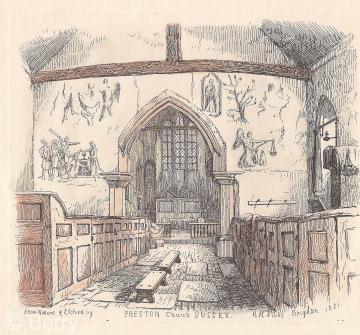St Peter's Church, Preston, City of Brighton and Hove

The work for the Victoria County History’s volume on the City of Brighton and Hove has revealed a considerable amount of repair and restoration work on most of the medieval churches between 1830 and 1914. Compared with some of the other churches, St Peters, the medieval parish church of the ancient parish of Preston was treated with a light hand.
This tiny church, a well-known landmark on the northern end of Preston Park managed to be mentioned in The Times twice in sixty years. On both occasions the church roof caught fire, at the same end and because of the heating system.
In 1830 some work on the church resulted in the rediscovery of frescos, which are probably from the C13th. The Rev. Charles Townshend ensured that both the Gentleman’s Magazine and the Archaeological Journal received a report from him and excellent drawings by William Twopenny.
At some time before February 1841, heating was installed in the church. In February 1841, the Sunday afternoon service was stopped by a fire in the roof, which had begun some time before it was spotted by two people passing by. Mainly railway workers who were then building the line from London to Brighton extinguished it. The railway men pulled tiles off the roof to douse the flames with water. Then, buckets of water from local ponds and wells were used to contain and then extinguish the fire. This task was largely complete when the fire engines appeared from Brighton. The event attracted spectators, some of whom stood there telling people what to do. The roof did not fall in, nor were the wall paintings damaged. A ‘bursting of the flue’ for the heating boiler probably caused the fire.
By the late 1860s, more work was needed on the nave and the church required a new organ. The new organ, by Mannington was installed, just before Christmas 1873. Work on the restoration of the nave was completed in September 1874.This cost about £1,200. It was supervised by John Woodman (who designed Holy Trinity in Hove) and undertaken by Bruton. The old roof was replaced with oak beams and red tiles. More whitewash was removed from the walls. The author of an article about the work refers to the fashion for doing this and remarks that Mr. Ruskin would have approved. He notes that:
‘now the flint and stone walls are seen in their bare beauty, adding considerably to the effect of the church’
The brickwork used to block up the lower parts of the windows was removed, the floor was tiled, the box pews shown in the print by Nibbs were replaced with seats (which seem to have been chairs, not benches) the pulpit replaced and a new reading desk provided. The south door, which had opened on to a footpath, was closed and a small vestry added. A porch was added to the north door.
During the work, ‘Clark’s Patent Multitubalar Heater’ which consisted of several long pipes under the floor heated by a furnace, also beneath the building, was installed. Vere and Ellen Bennet-Stanford then undertook some repair work to the chancel for which they employed Ewan Christian in 1877-78. The stencil decoration survived the fire mentioned below. The Vestry did consider enlarging the church in 1899 and commissioned a report from Sir Arthur Blomfield. He was asked to consider two options, whether to enlarge St Peters or build a new church. The change in attitude towards extending churches and the resultant loss of old fabric appears to have played a major role in the rejection of the idea of extending St Peter’s.
Blomfield designed St John the Evangelist in Knoyle Road to the north of St Peters which became the parish church in 1908.TheVestry then had to consider what to do with St Peters. Weddings and funerals were thought to be ideal.
In 1906 the little church was so badly damaged that it was newsworthy. Postcards showing the damage were sold. The fire began below the organ and gallery and spread along the roof and into the tower. The fire did not damage the chancel but the interior was badly affected by smoke and by water. P.M.Johnston, a local architect, supervised the restoration by H.J.Penfold and Co. The new stained glass windows were by A.H.J.Westlake.
Declared redundant in 1997, the church is now cared for by the Churches Conservation Trust. The key can be borrowed from the Crown and Anchor pub. Local members of the CCT open the church at weekends. There are some very interesting memorials in the graveyard; some to people who died in Brighton whilst here to sea bathe.
© Sue Berry
Content derived from research undertaken as part of the Victoria County History project
Content derived from research undertaken as part of the Victoria County History project


